The Composable Disaggregated Infrastructure Market is estimated to be valued at USD 5.7 billion in 2025 and is projected to reach USD 66.4 billion by 2035, registering a compound annual growth rate (CAGR) of 27.8% over the forecast period.
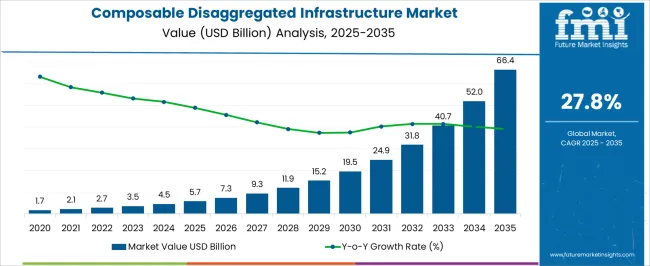
| Metric | Value |
|---|---|
| Composable Disaggregated Infrastructure Market Estimated Value in (2025 E) | USD 5.7 billion |
| Composable Disaggregated Infrastructure Market Forecast Value in (2035 F) | USD 66.4 billion |
| Forecast CAGR (2025 to 2035) | 27.8% |
The composable disaggregated infrastructure market is gaining strong momentum as enterprises shift toward modular, software defined architectures to enhance resource utilization and operational agility. Growing adoption of cloud native applications and data intensive workloads has accelerated demand for infrastructure models that can dynamically allocate compute, storage, and networking resources.
This approach enables cost efficiency by reducing over provisioning while improving scalability for hybrid and multi cloud environments. Continuous advancements in high speed interconnects and orchestration software are further supporting deployment across diverse industries.
Regulatory compliance, coupled with increasing emphasis on sustainability and efficient data center management, is also shaping adoption trends. The outlook remains favorable as organizations prioritize workload optimization, automation, and flexibility, positioning composable disaggregated infrastructure as a key enabler of next generation IT ecosystems.
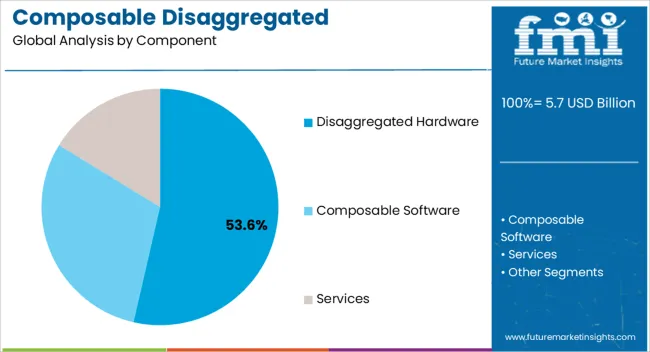
The disaggregated hardware segment is expected to hold 53.60% of total market revenue by 2025, making it the leading component. Its growth is being driven by the ability to separate compute, storage, and network resources, which reduces vendor lock in and enhances scalability.
Enterprises are increasingly valuing hardware that can be independently upgraded or replaced without requiring full system overhauls. This flexibility allows for significant cost savings and ensures longer infrastructure lifecycles.
Adoption has been strengthened by the rise of open standards and the growing ecosystem of compatible hardware components, making disaggregated hardware the cornerstone of composable architectures.
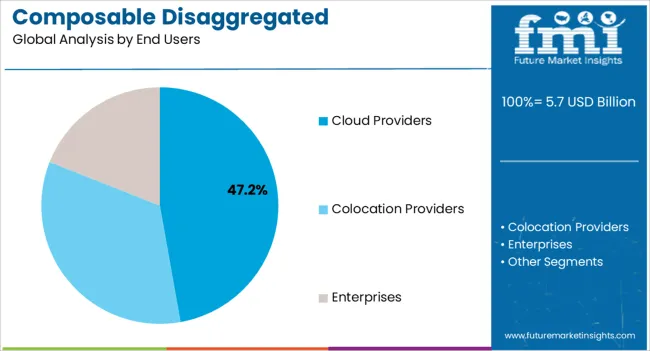
The cloud providers segment is projected to account for 47.20% of total revenue by 2025 under the end user category, positioning it as the dominant segment. This is due to the increasing demand for scalable infrastructure to support rapidly growing workloads, data intensive applications, and distributed cloud services.
Cloud providers benefit significantly from the ability of composable architectures to allocate resources dynamically, thereby maximizing efficiency and reducing downtime. The growing competition among hyperscalers has also spurred investments in infrastructure that improves customer experience and cost optimization.
As cloud providers continue to expand global operations, composable disaggregated infrastructure has emerged as a strategic enabler of service agility and competitiveness.
Enterprises are generating more data than ever, but they also need applications that can make sense of all this information. Many are turning to AI, big data analytics, and other advanced technologies that can derive meaningful insights from the data. Such applications require adequate IT infrastructure to support them.
Infrastructure alone is seldom enough. Requirements can vary significantly from one application to the next and even fluctuate within the same application. These changing application requirements make it difficult for traditional infrastructure to meet the demands of advanced workloads. For this reason, many organizations are now looking to composable disaggregated infrastructure.
The sales for composable-disaggregated infrastructure solutions are estimated to rise at 27.8% CAGR between 2025 and 2035 in comparison with the 24.3% CAGR registered during 2020 to 2025.
Integration with automation software assembling components dynamically into a complete solution for the workload is one of the primary growth factors for the market. An increasing number of IT enterprises are shifting to DevOps methodology for application development is also expected to contribute significantly to the composable disaggregated infrastructure market. Overall, dynamic applications of composable disaggregated infrastructure, and the growing awareness of them, are what drive the overall industry growth.
The global composable-disaggregated infrastructure growth scenario is anticipated to witness an increase in revenue from USD 5.7 billion in 2025 to USD 66.4 billion by 2035.
Adoption of Data-hungry Applications to Propel The Market
Data-hungry applications will create demand for new infrastructure architectures that can provide cloudlike agility and scale but with the on-premises security. Such infrastructure will need to shed the compute-centric design and be built using newer (radical) memory-centric principles. Composable-disaggregated infrastructure is an avenue to achieving that reality. Memory-centric infrastructure platforms built with low-latency, high-bandwidth fabrics have the potential to indelibly change the server and storage market dynamics.
Furthermore, the traditional siloed data center architectures are unable to provide the flexibility required by business critical applications of the modern world. Additionally, an increasing number of IT enterprises are shifting to DevOps methodology for application development, which requires an agile infrastructure to keep up with the rapidly evolving application demands and often uses an 'infrastructure as code' approach to optimize the allocation of resources.
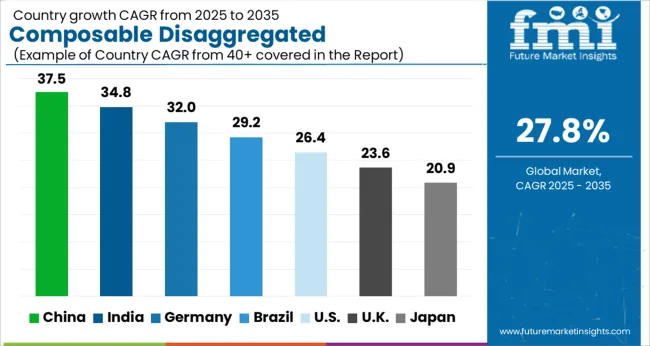
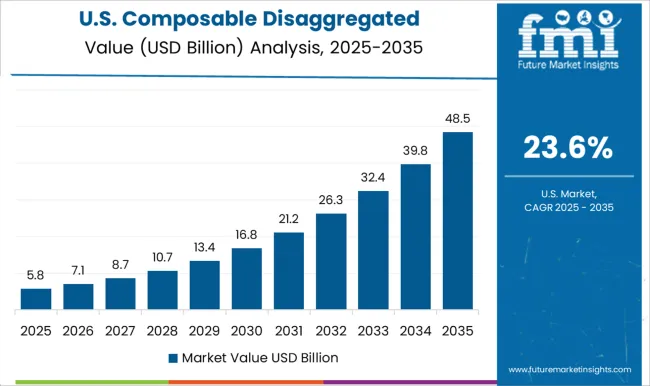
United States to Take Over The North America Industry
North America is predicted to remain one of the most attractive markets during the forecast period, according to Future Market Insights. According to the study, the USA is expected to account for more than 79% of the North American share through 2035. The presence of well-established players, such as HPE, Dell, DriveScale, and Liqid Inc. is the major factor driving the market growth in the USA Growing demand for enterprise applications and simplification of existing IT with the advent of new technologies are also improving the demand.
Surging demand for scalability in solutions, reduction in operational expenditure, and low total ownership cost on IT infrastructure are the prime factors driving the growth of the composable-disaggregated infrastructure demand in the USA
The economy of the USA comprises a better infrastructure and hence can provide better internet penetration. This helps in the faster implementation of new technologies, which is driving the adoption of composable-disaggregated infrastructure in the USA United State has emerged as a leading market, accounted for over 20.3% of the total demand registered in 2025.
Sophisticated Infrastructure to Boost The Market Growth
Sales in India are estimated to exhibit tremendous growth at 36.7% CAGR between 2025 & 2035. Demand for composable-disaggregated infrastructure has increased rapidly in major economies of South Asia and the Pacific, including India, Australia, and New Zealand, which has created lucrative growth opportunities for market participants.
The government in India has implemented a number of ICT initiatives under the National e-Governance Plan (NeGP), including the creation of ICT infrastructure both at the center and state levels.
The infrastructure thus created will provide the basis for the adoption of cloud computing for the government with the objective of making optimum use of existing infrastructure, reuse of applications, efficient service delivery to the citizens, and increasing the number of e-transactions in the country, thus helping achieve the ultimate goal of NeGP. Consequently, demand for composable-disaggregated infrastructure solutions is projected to rise at an impressive rate as enterprises seek cost-efficient solutions.
High Penetration of Digital Services to Propel The Market Growth in China
The market in the China is projected to rise at a CAGR of 27.4% over the upcoming decades. Small- and medium-sized businesses in China are adopting public and private cloud offerings for their digital transformation strategies, while enterprises are adopting a multi-cloud, hybrid approach. For all these scenarios, both, IT and DevOps teams are tasked with managing the ever-increasing complexity of the infrastructure to provide a better user experience.
China's growing adoption and optimization of digital services emphasize the need to deliver a top-notch user experience to customers. Companies are actively engaged in bridging the operational gap for DevOps and IT teams with their deep monitoring insights that provide better visibility into performance trends and user impact, reducing time to repair and refine.
High Flexibility of The System to Open Up Opportunities for The Segment
Based on components, disaggregated hardware accounted for a share of 59.3% of the overall share in 2025. Initial disaggregation of subsystems within physical servers begins with the decoupling of the storage and networking from the CPU and memory.
Networking is shared by all resources, CPU, and memory are housed on distinct nodes/trays from storage trays/nodes, and latency complications still prevent the separation of the CPU from the memory.
The disaggregation of the components provides ample flexibility in the architecture to achieve the best ratio of compute to I/O to storage for a wide range of workloads and provides the ability to compose optimal configurations to address compute-intensive, data-intensive, and/or balanced workloads based on the unique requirements of specific applications.
Enterprise Segment to Dominate The Market
The enterprise segment, among end users, is projected to register a massive demand, exhibiting noteworthy growth at a CAGR of 28.6% over the coming years. In today's enterprise, data can come from transactional systems, IoT devices, social media sites, weblogs, user devices, monitored IT systems, and a variety of other sources.
By deriving insights from this data, organizations can realize multiple benefits. For example, they might use this information to optimize IT operations or increase employee productivity. Alternatively, they might use it to improve customer services or gain a competitive edge.
Resources become elastic building blocks for delivering an optimal environment that's provisioned and configured to support a specific workload without having to wait on lengthy IT allocation processes. With composable-disaggregated infrastructure, enterprises can enhance configurations as workload requirements change, assembling and reassembling resources in response to evolving application and business requirements.
When the application no longer needs those resources, they're returned to the resource pool and are ready for use by other applications. Thus, enterprises are likely to witness tremendous growth over the forecast period.
SME Segment to Grow owing to Immense Business Opportunities
In terms of enterprise size, the market is segmented into small & medium enterprises (SMEs) and large enterprises. The SMEs segment is expected to register astounding growth at a CAGR of 27.9%, while also creating an incremental opportunity of USD 66.4 billion through 2035.
With today’s cutting-edge technologies, the IT landscapes of small- and mid-sized organizations tend to be just as complex as those of larger counterparts, just on a much smaller scale. A sound IT infrastructure, including the company network, is just as important to small- and mid-sized companies as it is to larger businesses. However, smaller companies often have small IT teams or even a single administrator.
Hence, auxiliary tools such as composable-disaggregated infrastructure solutions are gaining immense popularity among smaller businesses. Composable-disaggregated infrastructure has the potential to deliver incalculable value to mid-sized companies. Consequently, paving the way for lucrative opportunities within small- and mid-sized enterprises. Thereby propelling the market growth.
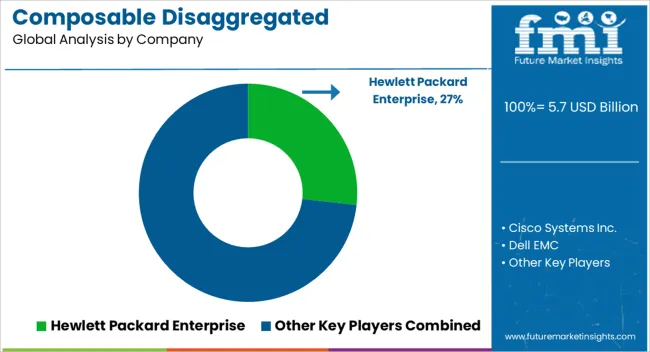
The composable-disaggregated infrastructure industry is highly concentrated and controlled by dominant players, like Hewlett Packard Enterprise, Cisco Systems Inc., Dell EMC, and Ericsson.
Key companies are focusing on the introduction of new solutions and strategic partnerships to increase their business revenue. However, with product innovations and technological advancements, midsize to smaller firms are growing their market presence by securing new contracts and tapping new markets.
| Attribute | Details |
|---|---|
| Forecast Period | 2025 to 2035 |
| Historical Data Available for | 2020 to 2025 |
| Composable Disaggregated Infrastructure Market Value (2025) | USD 5.7 billion |
| Composable Disaggregated Infrastructure Market Expected Value (2035) | USD 66.4 billion |
| Market Analysis | USD Million for Value |
| Key Regions Covered | North America; Latin America; Europe; East Asia; South Asia & Pacific; and the Middle East & Africa |
| Key Countries Covered | USA, Canada, Germany, UK, France, Italy, Spain, Russia, China, Japan, South Korea, India, Malaysia, Indonesia, Singapore, Australia & New Zealand, GCC Countries, Turkey, North Africa and South Africa |
| Key Segments Covered | Component, End User, Enterprise Size, and Region |
| Key Companies Profiled | Hewlett Packard Enterprise; Cisco Systems Inc.; Dell EMC; Ericsson; DriveScale, Inc. (Twitter); Wiwynn; Liqid Inc.; Fungible, Inc.; TidalScale |
| Customization & Pricing | Available upon Request |
The global composable disaggregated infrastructure market is estimated to be valued at USD 5.7 billion in 2025.
The market size for the composable disaggregated infrastructure market is projected to reach USD 66.4 billion by 2035.
The composable disaggregated infrastructure market is expected to grow at a 27.8% CAGR between 2025 and 2035.
The key product types in composable disaggregated infrastructure market are disaggregated hardware, composable software and services.
In terms of end users, cloud providers segment to command 47.2% share in the composable disaggregated infrastructure market in 2025.






Full Research Suite comprises of:
Market outlook & trends analysis
Interviews & case studies
Strategic recommendations
Vendor profiles & capabilities analysis
5-year forecasts
8 regions and 60+ country-level data splits
Market segment data splits
12 months of continuous data updates
DELIVERED AS:
PDF EXCEL ONLINE
5G Infrastructure Market Size and Share Forecast Outlook 2025 to 2035
IT Infrastructure Management Tools Market
Cloud Infrastructure Entitlement Management Market Report – Trends & Forecast 2024-2034
Cloud Infrastructure-As-A-Service Market
Virtual Infrastructure Manager Market Size and Share Forecast Outlook 2025 to 2035
Hosting Infrastructure Services Market Analysis - Size Share and Forecast Outlook 2025 to 2035
Managed Infrastructure Services Market Analysis by Solution, Application, and Region Through 2035
Carrier Infrastructure in Telecom Applications Market - Forecast 2025 to 2035
Cloud IT Infrastructure Hardware Market Size and Share Forecast Outlook 2025 to 2035
Wireless Infrastructure Market Size and Share Forecast Outlook 2025 to 2035
Catenary Infrastructure Inspection Market Insights - Demand & Forecast 2025 to 2035
Critical Infrastructure Monitoring Market
Critical Infrastructure Protection Market
Automated Infrastructure Management Solution Market Size and Share Forecast Outlook 2025 to 2035
Converged Infrastructure Management Market Size and Share Forecast Outlook 2025 to 2035
Oil & Gas Infrastructure Market Size and Share Forecast Outlook 2025 to 2035
Automated Infrastructure Management (AIM) Solutions Market Size and Share Forecast Outlook 2025 to 2035
Converged Infrastructure Market
Datacenter Infrastructure Services Market Size and Share Forecast Outlook 2025 to 2035
Public Key Infrastructure (PKI) Market Analysis - Growth & Forecast through 2034

Thank you!
You will receive an email from our Business Development Manager. Please be sure to check your SPAM/JUNK folder too.
Chat With
MaRIA